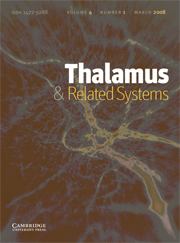No CrossRef data available.
Article contents
The influence of one, powerful thalamocortical neuron on an inhibitory cortical circuit
Published online by Cambridge University Press: 26 April 2007
Abstract
Mircea Steriade exerted a powerful, driving influence on systems neuroscience for nearly five decades. Here, we review the case of a influential individual of another sort: a single thalamocortical (TC) neuron that exerts an extraordinary influence on fast-spike interneurons of somatosensory ‘barrel’ cortex. This cell was studied over a period of several days in an awake rabbit using methods of extracellular cross-correlation. In many ways, the influence of this TC neuron on topographically aligned fast-spike interneurons is typical of TC inputs to these cells, manifested as a fast-rising, very brief increase in postsynaptic spike probability. However, this TC neuron was distinct from other TC neurons studied because of the potency of that influence and the number of interneurons influenced. In one of these recipient interneurons, the probability of spike generation within a narrow window (0.7 msec) following a TC spike was 21%, and this value reached 53% for TC spikes with long preceding interspike intervals (conditions that allow recovery from chronic, activity-dependent depression at the TC synapse). Based on these data, we maintain that, in the awake state, spontaneous spikes of single TC neurons drive some classes of cortical neurons powerfully. Moreover, we suggest that neighboring TC neurons (like neuroscientists) vary greatly in their global ‘driving influence’ on recipient neocortical circuits, and that a few of these cells exert a disproportionate impact on cortical networks.
- Type
- Research Article
- Information
- Copyright
- © 2007 Cambridge University Press


